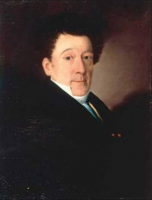










Giuseppe Zamboni (June 1, 1776 – July 25, 1846) was an Italian Roman Catholic priest and physicist who invented the Zamboni pile, an early electric battery similar to the Voltaic pile.
Priest and physicist, born at Venice, June, 1776; died there 25 July 1846. Shortly after completing his studies in the seminary at Verona, Abate Zamboni was appointed to the chair of physics in the lyceum of that city. Zamboni is known to students of physics by the "dry" pile which he invented in 1812, and which consists of a number of paper discs coated with zinc foil on one side and manganese binoxide on the other, the moisture of the paper serving as conductor. By pressing a large number of such discs together in a glass tube, an electromotive force can be obtained sufficient to deflect the leaves of an ordinary electroscope. By bringing the terminal knobs of the pile near each other and suspending a light brass ball between them, Zamboni devised what was called an electric clock, the ball oscillating between the knobs like a pendulum. In the Claredon Laboratory, Oxford, the terminals of such a pile are fitted with bells which have been continuously ringing for the last fifty years. The Zamboni pile is not, however, a perpetually-going motor, as all action when the zinc is completely oxidized or the manganese exhausted. Among Zamboni's works are: "Della pila elettrica a secco" (Venice, 1812); "L'elettromotore perpetuo" (Venice, 1820); "Descrizione d'un nuovo galvanometro" (Venice, 1833).